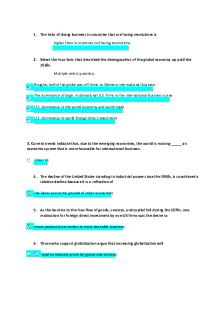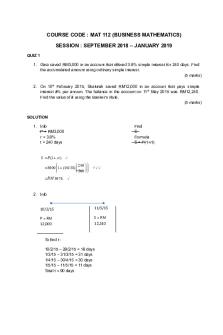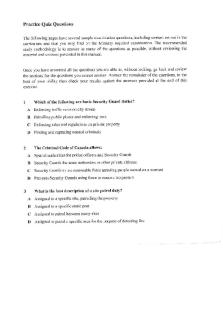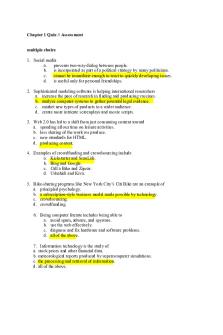Patho Practice Quiz 1 PDF

| Title | Patho Practice Quiz 1 |
|---|---|
| Author | Jessica Widner |
| Course | Pathophysiology |
| Institution | Chamberlain University |
| Pages | 5 |
| File Size | 133.1 KB |
| File Type | |
| Total Downloads | 6 |
| Total Views | 177 |
Summary
Practice quiz...
Description
Patho Practice Quiz 1
1) Which of the following would be the most likely cause of an iatrogenic disease? An unwanted effect of a prescribed drug 2) Which of the following is considered a systemic sign of disease? Fever 3) Etiology is defined as the study of the: cause of disease 4) A type of cellular adaptation in which there is a decrease in cell size is referred to as: atrophy. 5) A deficit of oxygen in the cells usually due to respiratory or circulatory problems is called: ischemia. 6) When a group of cells in the body dies, the change is called: necrosis 7) Rigorous weight lifting/body building regimens may result in the skeletal muscle cells undergoing: hypertrophy 8) The term cancer refers to: malignant neoplasm. 9) To which of the following does the term apoptosis refer? Preprogrammed cell selfdestruction 10) Routine application of sun block to skin would be an example of: a preventive measure. 11) A circumstance that causes a sudden acute episode of a chronic disease to occur is termed: precipitating factor. 12) The term homeostasis refers to: maintenance of a stable internal environment. 13) Pathophysiology involves the study of: functional or structural changes resulting from disease processes. 14) Which of the following is the best definition of epidemiology? The science of tracking the occurrence and distribution of diseases 15) Which of the following can cause cell injury or death? 1. Hypoxia 2. Exposure to excessive cold 3. Excessive pressure on a tissue 4. Chemical toxins 16) The term disease refers to: a deviation from the normal state of health and function 17) A collection of signs and symptoms, often affecting more than one organ or system, that usually occur together in response to a certain condition is referred to as a (an): syndrome. 18) A short-term illness that develops very quickly with perhaps a high fever or severe pain is called: acute 19) The term prognosis refers to the: expected outcome of the disease. 20) When prolonged ischemia occurs to an area of the heart, the resulting damage is referred to as: infarction. 21) Cell damage may be caused by exogenous sources such as: certain food additives. 22) A situation when there is a higher than expected number of cases of an infectious disease within a given area is called a/an: pandemic 23) Choose the correct proportion of water to body weight to be expected in a healthy male adult’s body: 60%
24) Choose the correct proportion of blood (to body weight) in an adult male’s body: 4% 25) Insensible fluid loss refers to water lost through: perspiration and expiration 26) Which of the following would result from a deficit of plasma proteins? Decreased osmotic pressure 27) Which of the following would cause edema? Increased capillary permeability 28) Which of the following would likely be related to an elevated hematocrit reading? Fluid deficit 29) Which of the following is a typical sign of dehydration? Rough oral mucosa 30) Which of the following is the primary cation in the extracellular fluid? Sodium 31) Which of the following is a common cause of hyponatremia? Excessive sweating 32) Which of the following results from hypocalcemia? 1. Low serum phosphate levels 2. Nausea and constipation 3. Skeletal muscle twitch and spasms 4. Weak cardiac contractions 33) Which of the following causes tetany? Increased permeability of nerve membranes due to low serum calcium 34) Which of the following would be considered normal serum pH? 7.4 35) When many excess hydrogen ions accumulate in the blood, what happens to serum pH? The pH: decreases 36) What is the slowest but most effective control for acid-base balance? Kidneys 37) Which of the following is essential in order to maintain serum pH within normal range? The ratio of carbonic acid to bicarbonate ion must be 1:20 38) The impulses related to acute pain are usually transmitted by: myelinated A delta fibers. 39) According to the gate-control theory, passage of pain impulses may be naturally blocked: at the synapse by entry of other sensory impulses 40) What is the term used to describe the degree of pain that is endured before an individual takes action? Pain tolerance 41) What is the definition of endorphins? Opiate-like blocking agents in the central nervous system 42) Pain perceived in the left arm during the course of a heart attack is an example of: Referred Pain 43) A headache that is related to changes in cerebral blood flow is classified as a/an ________ headache. Migraine 44) Which of the following is a characteristic of acute pain but not of chronic pain? Severe but short term 45) What is the role of nociceptors? They are: Pain receptors that are stimulated by thermal,
chemical, or physical means 46) Intractable pain is best defined as: Severe pain that cannot be controlled by medication 47) Pain that is caused by trauma or disease involving the peripheral nerves is referred to as: Neuropathic pain 48) Pain resulting from a profound, sudden loss of blood flow to an organ or tissues in a specific area of the body is referred to as: Ischemic pain 49) Which of the following is a characteristic of chronic pain? It is more difficult to diagnose and treat than is acute pain.
50) Which of the following is a characteristic of a benign tumor? Cells appear relatively normal. 51) Which factor provides the basis for the grading of newly diagnosed malignant tumors? Degree of differentiation of the cells 52) A warning sign of possible cancer would be any of the following EXCEPT: a sudden development of fever, nausea, & diarrhea 53) Which term refers to the spread of malignant cells through blood and lymph to distant sites? Metastasis 54) What would be an external source of ionizing radiation? Gamma rays delivered by a cobalt machine 55) Radiation therapy destroys: primarily rapidly dividing cells. 56) The development of neutropenia during chemotherapy for cancer means: the patient is at high risk for infection. 57) Vomiting frequently follows a chemotherapy treatment because: the gastrointestinal tract is irritated & the chemicals stimulate the emetic center. 58) What type of normal cells are often damaged during chemotherapy and radiation treatments? Epithelial cells 59) Remission for cancer is generally defined as a period in which: signs and symptoms are absent. 60) High risk factors for cancer include: 1. human papilloma virus. 2. chronic irritation and inflammation. 3. repeated sun exposure. 4. high family incidence. 61) The warning signs for cancer include: -unusual bleeding. -change in a wart or mole (e.g., color). -a new solid lump, often painless. 62) A classification process that applies to a specific malignant tumor and describes the extent of the disease at a given time is called: staging 63) Benign tumors in the brain are often life-threatening because they: create excessive pressure within the skull. 64) One of the general effects of a malignant cancer is cachexia, which is: severe tissue wasting. 65) Which of the following statements applies to the sex chromosomes? They are numbered pair 23 in the karyotype. 66) What is characteristic of a congenital disorder? it is usually manifested in the noenatal period 67) In the case of an X-linked recessive disorder, a carrier mother and unaffected father could produce a/an: normal female 68) Down syndrome is an example of a/an: chromosomal disorder 69) Agents that cause damage during embryonic or fetal development are called: tetrogenic 70) What is an example of a multifactorial congenital disorder? Cleft lip and palate 71) Which of the following statements applies to Huntington’s disease? there is a test for the defective gene
72) A mother is a carrier of Duchenne muscular dystrophy; the father is unaffected. They have one son with muscular dystrophy. Another male child is expected. The probability of the second son having muscular dystrophy is: 50% 73) Hemophilia A has been diagnosed in a young boy. He has inherited this defective gene from: his mother 74) Which of the following are common manifestations of Down syndrome? 1. Congenital heart defect 2. Cleft lip and palate 3. Large protruding tongue 4. Limited intellectual development 75) A person with sickle cell trait that is heterozygous has: an incomplete dominant gene 76) TORCH is an acronym for routine prenatal screening tests for high-risk maternal infections; TORCH stands for: toxoplamosis, other, rubella, cytomeglavoirus and herpes 77) The most invasive prenatal screening test for fetal abnormalities is: amniocentesis. 78) Which of the following can be detected using amniotic fluid? Chromosomal abnormalities Metabolic disorders, Certain structural abnormalities 79) When genetic influences combine with environmental factors to cause an abnormality, the result is called a: Multifactorial disorder 80) Which condition is likely to cause metabolic acidosis? Prolonged Diarrhea 81) Compensation mechanisms in the body for dehydration would include: Increased ADH 82) Which acid-base imbalance results from impaired expiration due to emphysema? Respiratory acidosis 83) Which of the following is a manifestation of respiratory alkalosis? Increased nervous system irritability 84) Prolonged diarrhea results in: Loss of fluid and bicarbonate ions leading to metabolic acidosis 85) In the initial stage, vomiting results in: Metabolic alkalosis 86) Which two ions are most important for acid-base balance in the body? Cl- & HCO3 87) The bicarbonate-carbonic acid buffer system helps maintain serum pH. The balance of the carbonic acid and bicarbonate ion levels are controlled by the: Lung and Kidney 88) Hypocalcemia causes weak cardiac contractions because: insufficient calcium ions are available for muscle contraction 89) Serum potassium levels are affected by: 1. ADH. 2. aldosterone. 3. serum H+ levels. 4. insulin levels. 90) Which of the following is the primary control of serum Na+ levels? Aldosterone 91) The control center for thirst is located in the: hypothalamus 92) Which statements apply to atrial natriuretic peptide? 1. It is secreted by heart muscle cells. 2. It is a hormone secreted by the kidneys. 3. It helps to control water and sodium balance. 4. It is released in response to low blood pressure. 93) What are the three mechanisms that control or compensate for serum pH? Buffer pairs in blood, change in kidney excretion rste, change in respiration rate
94) Hypokalemia refers to a condition in which the serum has a very low level of which ion? Potassium 95) In the blood and extracellular fluids, hypernatremia refers to: an excess sodium level...
Similar Free PDFs

Patho Practice Quiz 1
- 5 Pages

Patho-quiz-2 - Helpful
- 30 Pages

Sample Quiz #1 - Practice Quiz
- 2 Pages

Chapter 1 - quiz practice
- 5 Pages

HW 1 - Quiz Practice
- 7 Pages

Practice Quiz 1
- 2 Pages

QUIZ 1 MAT112 Practice
- 2 Pages

Practice Quiz 1 - Exam
- 24 Pages

Practice Quiz 1
- 11 Pages

Patho-Exam1 - Exam 1
- 6 Pages

Patho Exam 1 questions
- 6 Pages

Patho Assignment 1
- 3 Pages

MGT2381 Chapter 1 Practice Quiz
- 6 Pages
Popular Institutions
- Tinajero National High School - Annex
- Politeknik Caltex Riau
- Yokohama City University
- SGT University
- University of Al-Qadisiyah
- Divine Word College of Vigan
- Techniek College Rotterdam
- Universidade de Santiago
- Universiti Teknologi MARA Cawangan Johor Kampus Pasir Gudang
- Poltekkes Kemenkes Yogyakarta
- Baguio City National High School
- Colegio san marcos
- preparatoria uno
- Centro de Bachillerato Tecnológico Industrial y de Servicios No. 107
- Dalian Maritime University
- Quang Trung Secondary School
- Colegio Tecnológico en Informática
- Corporación Regional de Educación Superior
- Grupo CEDVA
- Dar Al Uloom University
- Centro de Estudios Preuniversitarios de la Universidad Nacional de Ingeniería
- 上智大学
- Aakash International School, Nuna Majara
- San Felipe Neri Catholic School
- Kang Chiao International School - New Taipei City
- Misamis Occidental National High School
- Institución Educativa Escuela Normal Juan Ladrilleros
- Kolehiyo ng Pantukan
- Batanes State College
- Instituto Continental
- Sekolah Menengah Kejuruan Kesehatan Kaltara (Tarakan)
- Colegio de La Inmaculada Concepcion - Cebu


